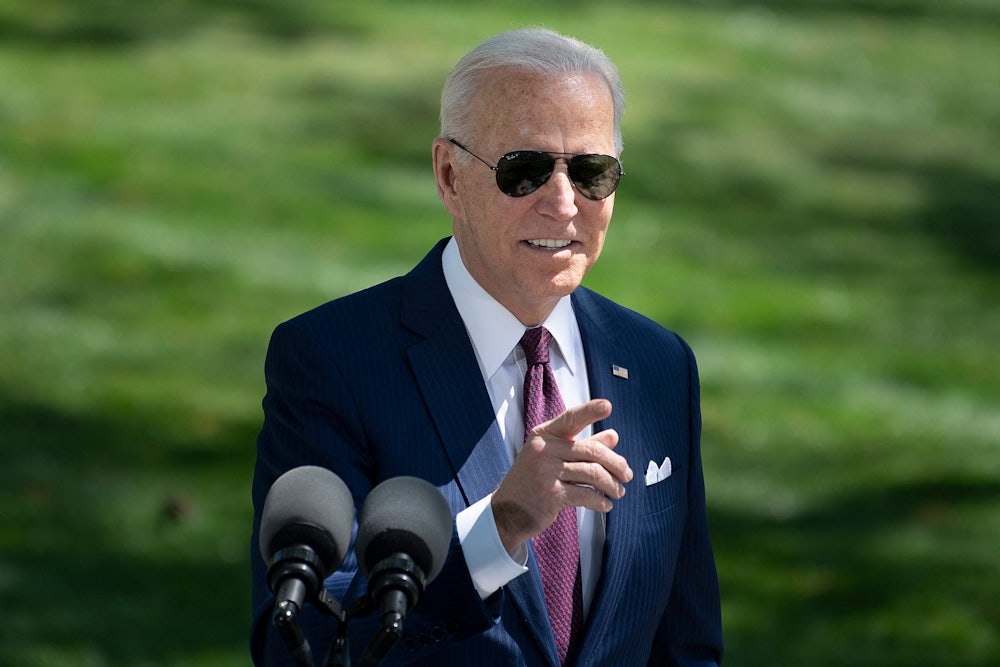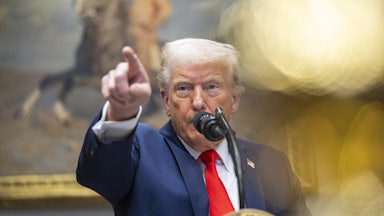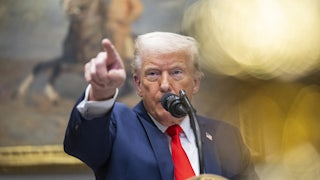One hundred days in, what do we know about Bidenism as it pertains to the climate crisis? Expectations started out fairly low: Few expected the 78-year-old career centrist, who voted for the North American Free Trade Agreement and the Iraq War, waxed poetic about austerity during the Obama administration, and campaigned during the 2020 Democratic primary on one of the most tepid climate plans in the field, to turn into Captain Planet overnight. The Joe Biden of the early 2020 primaries didn’t sound like the type of president who would pass a $1.9 trillion spending package, or put forward an expansive $4 trillion infrastructure proposal aiming in part to take on the “existential threat” of climate change. Yet that is precisely what he has already done.
It sets climate watchers the task of holding two contradictory principles in their heads simultaneously. This is far better than what might have happened had Biden followed through on earlier instincts to hand responsibility for fiscal and climate policy over to the likes of Larry Summers and Ernie Moniz. But as Sunrise Political Director Evan Weber put it to me over the phone, it’s been “historic, unprecedented, and nowhere near enough.” At the center of this contradiction is also a lesson for the rest of the Biden presidency, and for closing the gap between American politics’ low bar for climate progress and the objective scale of the crisis.
Biden’s infrastructure proposal, which hasn’t passed, is drastically smaller than the at least $10 trillion of domestic spending many experts estimate will be needed to start dealing with the climate crisis. But understanding how Joe Biden came to such a (relatively) ambitious sum in his first 100 days can help explain what will push him even further.
It’s worth taking stock of what’s changed between the eras of Vice President Joe Biden and President Joe Biden. As a response to a too-small stimulus, lavish bank bailout, and sluggish recovery at the start of the Obama administration, Occupy Wall Street put gaping wealth and income inequality in the spotlight. Not long after, the movement for Black lives made it impossible for the public to continue ignoring rampant police killings and a malignant system of mass incarceration. Fights against the Keystone XL and Dakota Access pipelines put a target on fossil fuel infrastructure and highlighted centuries-long fights for Indigenous sovereignty, while helping to inject the mainstream climate movement with an anti-corporate lens and more awareness of and focus on environmental justice. Bernie Sanders—a democratic socialist—got within striking distance of the Democrats’ presidential nomination in 2016 and 2020, galvanizing tens of thousands of young people into electoral politics around a broadly redistributive agenda. Among them was Alexandria Ocasio-Cortez, who beat out one of the most powerful Democrats in the House and, in her first week on the job, joined the Sunrise Movement to occupy her new boss’s office, demanding a Green New Deal. That call, in turn, has gone on to shape climate policy debates the world over.
Politics, in other words—including climate politics—has changed a lot over the last decade. Joe Biden has changed with it. So have the advisers surrounding him, who notably do not include Larry Summers or Timothy Geithner, the architects of Obama’s stimulus policies. Many of the wonks now advising the White House spent formative professional years in grad school and policy shops postrecession and saw the consequences of a too-slow stimulus and too-small recovery play out. They’re no doubt eager to avoid the resulting political blowback that saw Democrats lose the House, Senate, White House, and countless state legislatures. Biden’s governing agenda on climate and other issues comes out, as well, of a series of “unity task forces” convened after the Democratic primary, bringing together Sanders supporters with team Biden to hash the nominee’s stances.
Of course, none of these recommendations are policy yet. The proposed infrastructure package that resulted from those discussions—and many since—still has to get through a tremendously undemocratic political system, subject to obstruction from both a GOP eager to block anything that might make Biden look good and the idiosyncratic conservative Democrats that want to appease it. And there are already signs Biden is beginning to back off the more aggressive climate rhetoric he offered during his first month. As E&E News’s Adam Anton reported in his retrospective on the last hundred days, “Biden has recast climate change as just one of several challenges. Depending on the day or the audience, global warming can be an ‘existential threat’—or up for negotiation.”
The battles won so far at the White House haven’t been the result of either collegial Zoom meetings or wonkish enlightenment but years of disruptions to business as usual that force politicians—Biden very much included—to reorient as they change the political weather. It’s unlikely Sunrise would have an audience with the White House, for instance, if it hadn’t organized a 2018 sit-in for a Green New Deal, offending the sensibilities of seasoned Washington staffers. The pandemic has obviously shifted political winds, too, and made fewer of those in-person disruptions possible.
So while the center-left and establishment Democrats tend to bridle at any criticism of Biden this early in his term, the truth is that he hasn’t actually faced much: While progressive groups promised Biden wouldn’t get the kind of honeymoon period Obama had in the run-up to the election, his first hundred days haven’t seen much in the way of true leftist agitation. With 100 days passed and Covid-19 restrictions beginning to ease, there may be more to come from climate activists getting increasingly anxious about the fact that a Democratic White House and Congress still haven’t passed any climate policy as the 2022 midterms creep closer. Where is the hard line on fracking? Where is some policy—any policy—to curtail fossil fuel production? Will Biden move to cancel the Dakota Access and Line 3 pipelines, or commit more than 1 percent of gross domestic product to take on an existential threat?
“I think the mood of the country after Joe Biden’s election was one of both relief and, ‘Hey, let’s give this guy a chance.’ I think both of those moods are shifting as the American people’s problems persist,” says Weber. “We’ve given the guy a chance, so I think that you’re going to see more and more movement energy and more and more people taking to the streets, and taking our fight in a more agitational way to the people in power.”








